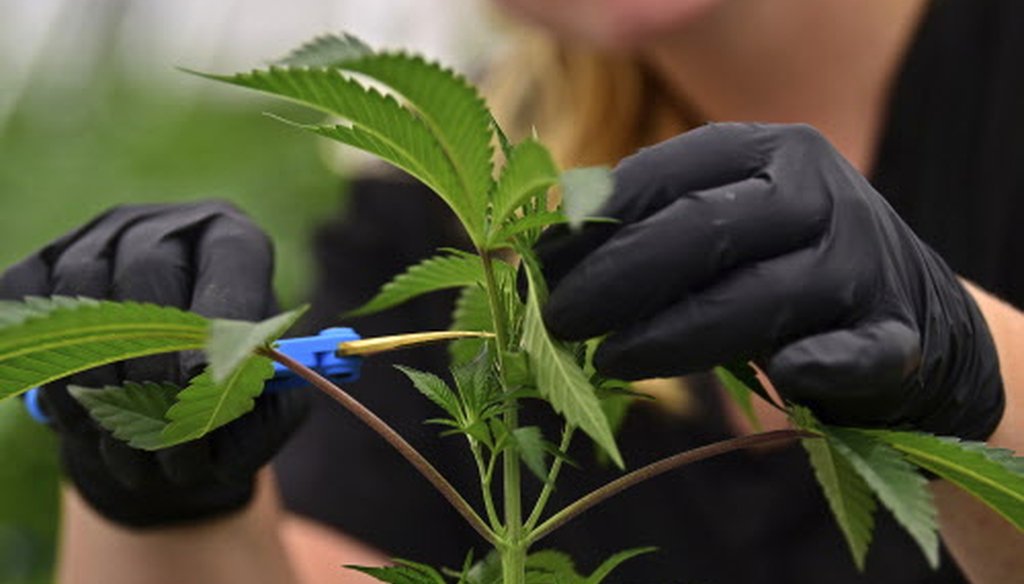Stand up for the facts!
Our only agenda is to publish the truth so you can be an informed participant in democracy.
We need your help.
I would like to contribute

Marijuana is a Schedule I hallucinogenic substance under the Wisconsin Uniform Controlled Substances Act. Penalties can vary, depending upon the amount or whether it is person’s is a first or multiple offender. (Associated Press)
Yes, marijuana is stronger than it used to be
If Your Time is short
-
Research shows that the THC content of marijuana has increased significantly since the 1970s.
-
The change can be attributed to several factors, including better knowledge of how to grow the cannabis plant.
Wisconsin Republicans have been blunt about their opposition to legalizing marijuana.
Gov. Tony Evers proposed legalizing recreational and medical marijuana in his 2021-’23 state budget as a way to bring in more revenue that he’d put toward rural schools and marginalized communities. Some GOP lawmakers have signaled they could support medical use, but the measure is not given much hope for passage.
State Rep. Barbara Dittrich, R-Oconomowoc, published a column on her legislative web page on Feb. 16, 2021 titled "Gaslighting Marijuana" that touched on a range of arguments against legalization. One line in particular caught our eye.
"There is the pervasive, false perception that marijuana is not dangerous," Dittrich wrote. "Pot today is not the weed baby boomers were smoking."
Is Dittrich right that modern marijuana is different than the grass of Woodstock past?
The evolution of marijuana
Dittrich’s argument centers around the amount of THC — the chemical that produces a high — in dried marijuana leaves and wax used for vaping devices. When asked for evidence to support her claim, an aide provided links to several articles about the drug and its health impacts.
In 2015, Andy LaFrate of the marijuana testing lab Charas Scientific said the average potency of marijuana the lab tested had reached 20% THC — an increase from where it was 20 or 30 years prior.
"I would say the average potency of marijuana has probably increased by a factor of at least three," LaFrate said in a video from the American Chemical Society.
That tracks with other research done on this topic. One study in 2019 found marijuana potency on average increased from 8.9% in 2008 to 17.1% in 2017. Another group of researchers indicated THC amounts were as low as 4% in 1995.
By contrast, THC content reached 22% and 67% in parts of the Netherlands, according to a study in Europe. Products with an average potency of 14% represented most of the London street market, while Italy, France and Spain saw marijuana with less than 10% THC.
Today’s potency depends in part on whether the marijuana comes from the legal or black market, said Susan Weiss, director of the Division of Extramural Research at the National Institute on Drug Abuse. Marijuana recently seized by the Drug Enforcement Administration tests between 12 to 14% on average, she said, compared to 3% or less in the 1970s and 1980s. But dispensaries sell products with up to 20% THC.
The change over time can be attributed to several factors, Weiss said: Marijuana back in the day was largely imported from Mexico, and potency would have decreased as it sat before being distributed. People also know more about the genetics of the plant now and can grow it in more controlled environments. Plus, the demand exists for a stronger product.
"Just as you can breed for better tomatoes, you can breed for higher potency plants," Weiss said.
Marijuana users also have more options today by way of concentrates like wax and oil that can be used for vaping — which are even stronger than dried cannabis.
In 2014, the head of the DEA told lawmakers that the THC content of those products averaged 54%, with some as high as 99%. According to NIDA, solvent-based products range on average from 54 to 69% THC, while non-solvent products have levels between 39 to 60%.
Our ruling
In a column, Dittrich said "pot today is not the weed baby boomers were smoking."
Research shows that the THC content of marijuana has increased significantly since the 1970s amid shifting trends in the industry and a greater understanding of the cannabis plant.
We rate Dittrich’s claim True.
Our Sources
-
Email from Meagan Matthews, research assistant for Rep. Barbara Dittrich, March 8, 2021.
-
American Chemical Society, Marijuana Testing Yields Fascinating Results, March 23, 2015.
-
European Archives of Psychiatry and Clinical Neuroscience, New trends in cannabis potency in USA and Europe during the last decade (2008-2017), Jan. 22, 2019.
-
Biological Psychiatry, Changes in Cannabis Potency Over the Last 2 Decades (1995-2014): Analysis of Current Data in the United States, April 1, 2016.
-
The Lancet, The contribution of cannabis use to variation in the incidence of psychotic disorder across Europe (EU-GEI): a multicentre case-control study, March 19, 2019.
-
Drug Enforcement Administration, Statement of the Honorable Michele Leonhart, administrator Drug Enforcement Administration before the United States House of Representatives Committee on Appropriations Subcommittee on Commerce, Justice, Science and Related Agencies, April 2, 2014.
-
Interview with Susan Weis, director of the Division of Extramural Research at the National Institute on Drug Abuse, March 16, 2021.
- National Institute on Drug Abuse, Marijuana Concentrates DrugFacts, accessed March 16, 2021.
Browse the Truth-O-Meter
More by Haley BeMiller
Yes, marijuana is stronger than it used to be
Support independent fact-checking.
Become a member!
In a world of wild talk and fake news, help us stand up for the facts.


















































